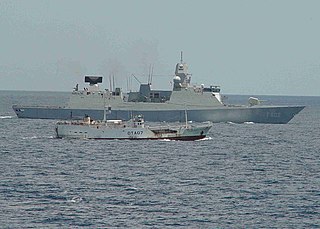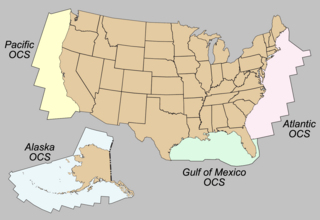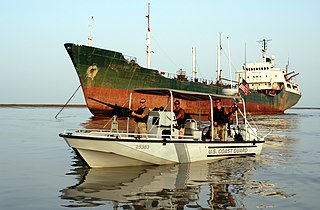
The International Maritime Organization (IMO), known as the Inter-Governmental Maritime Consultative Organization (IMCO) until 1982, is a specialised agency of the United Nations responsible for regulating shipping. The IMO was established following agreement at a UN conference held in Geneva in 1948 and the IMO came into existence ten years later, meeting for the first time in 1959. Headquartered in London, United Kingdom, the IMO currently has 174 member states and three associate members.

A coast guard or coastguard, is a maritime security organization of a particular country. The term implies widely different responsibilities in different countries, from being a heavily armed military force with customs and security duties to being a volunteer organization tasked with search and rescue functions and lacking any law enforcement powers. However, a typical coast guard's functions are distinct from typical functions of both the navy and a transportation police.
The captain of the port is an official who has different functions in the United Kingdom, the United States, and other countries.

The Canadian Coast Guard is the coast guard of Canada. Formed in 1962, the coast guard is tasked with marine search and rescue, communication, navigation and transportation issues in Canadian waters, such as navigation aids and icebreaking, marine pollution response and providing support for other Canadian government initiatives. The coast guard operates 119 vessels of varying sizes and 22 helicopters, along with a variety of smaller craft. The Canadian Coast Guard is headquartered in Ottawa, Ontario, and is a special operating agency within Fisheries and Oceans Canada.

The International Ship and Port Facility Security (ISPS) Code is an amendment to the Safety of Life at Sea (SOLAS) Convention (1974/1988) on minimum security arrangements for ships, ports and government agencies. Having come into force in 2004, it prescribes responsibilities to governments, shipping companies, shipboard personnel, and port/facility personnel to "detect security threats and take preventative measures against security incidents affecting ships or port facilities used in international trade."
The United States Coast Guard carries out three basic roles, which are further subdivided into eleven statutory missions. The three roles are:
Marine safety is one of the eleven missions of the United States Coast Guard.

Vietnam Coast Guard is the coast guard of Vietnam. It is a branch of Vietnam's military, the Vietnam People's Army, and falls under the management of the Vietnamese Ministry of Defence. Since its creation in the late 1990s, the Vietnam Coast Guard plays an important role in maintaining sea security and protection of the exclusive economic zone (EEZ) and continental shelf boundary. It has dispatched forces in waters in overlapping areas between Vietnam and foreign countries, providing protection and assistance to local fishermen when necessary. In addition, the Vietnam Coast Guard perform search and rescue duties, along with their duties of combating and preventing smuggling, piracy, and trade fraud in Vietnamese waters.

Visit, board, search, and seizure (VBSS) is the term used by United States military and law enforcement agencies for maritime boarding actions and tactics. VBSS teams are designed to capture enemy vessels, combat terrorism, piracy and smuggling, and to conduct customs, safety and other inspections.

Maritime security operations (MSO) are the actions of modern naval forces to "combat sea–based terrorism and other illegal activities, such as hijacking, piracy, and slavery, also known as human trafficking." Ships assigned to such operations may also assist seafaring vessels in distress. These activities are part of an overall category of activities which fall short of open warfare called military operations other than war (MOOTW). MSO also involve the marine environmental protection, creating a safer and clean environment.
Sector Commander is the position title of the commanding officer of a United States Coast Guard Sector, usually of the rank of Captain (O-6). The Sector Commander's second-in-command is the Deputy Sector Commander. Also reporting directly to the Sector Commander are the Command Master Chief (CMC), the Senior Reserve Officer, and the Sector's Auxiliary Coordinator.
A Sector is a shore-based operational unit of the United States Coast Guard. Each Sector is responsible for the execution of all Coast Guard missions within its Area of Responsibility (AOR), with operational support from Coast Guard Cutters and Air Stations. Subordinate commands within a Sector typically include Stations and Aids-to-Navigation (ATON) Teams. Some Sector commands also have subordinate units such as Sector Field Offices and Marine Safety Units that are responsible for mission execution in parts of the Sector's AOR. There are 37 sectors within the Coast Guard.
Maritime Security Regimes are codes and conventions of behavior agreed upon by coastal states to provide a degree of security within territorial waters and on the high seas.

United States Coast Guard Activities Europe (ACTEUR) is a Coast Guard Marine Safety unit located in Schinnen, The Netherlands.
In the United States, several federal agencies and laws have some jurisdiction over pollution from ships in U.S. waters. States and local government agencies also have responsibilities for ship-related pollution in some situations.

The Bangladesh Coast Guard (Bengali: বাংলাদেশ কোস্ট গার্ড is the maritime law enforcement force of Bangladesh. It is a paramilitary force which is under the jurisdiction of the Ministry of Home Affairs. Its officers are transferred from the Bangladesh Navy. The Bangladesh Coast Guard also performs the duty of maritime border security of Bangladesh. The headquarters is located in Dhaka, Bangladesh. Currently the coast guard has 3,339 personnel and 63 ships. A huge modernisation plan named Coast Guard Goal 2030 has been undertaken to enhance its capabilities.

The Deployable Operations Group (DOG) was a United States Coast Guard command that provided properly equipped, trained and organized Deployable Specialized Forces (DSF) which still exist today. To the Coast Guard, DHS, DoD and inter-agency operational and tactical commanders. Formerly headquartered in Arlington, Virginia, it was established on 20 July 2007, and was commanded by a captain and was decommissioned by the Commandant of the Coast Guard, Admiral Robert Papp on 1 October 2013. Although many of the units existed long before the 2007 commissioning. Upon decommissioning, the units previously assigned to the DOG were split between Coast Guard Pacific and Atlantic Area commands.
Floating armouries are vessels used to store military grade weapons. Being in possession of military-grade weapons in most jurisdictions is highly controlled. In the early twenty-first century, piracy in international waters became a serious issue for shipping companies. In response, services that supply weapons on the high seas, often referred to as floating armouries, were implemented. These armouries provide transfer services to private maritime security companies (PMSCs); the controlled weapons are available in international waters, but never enter patrolled territorial waters—they are delivered by an armoury to a client's vessel, and returned, in international waters.















